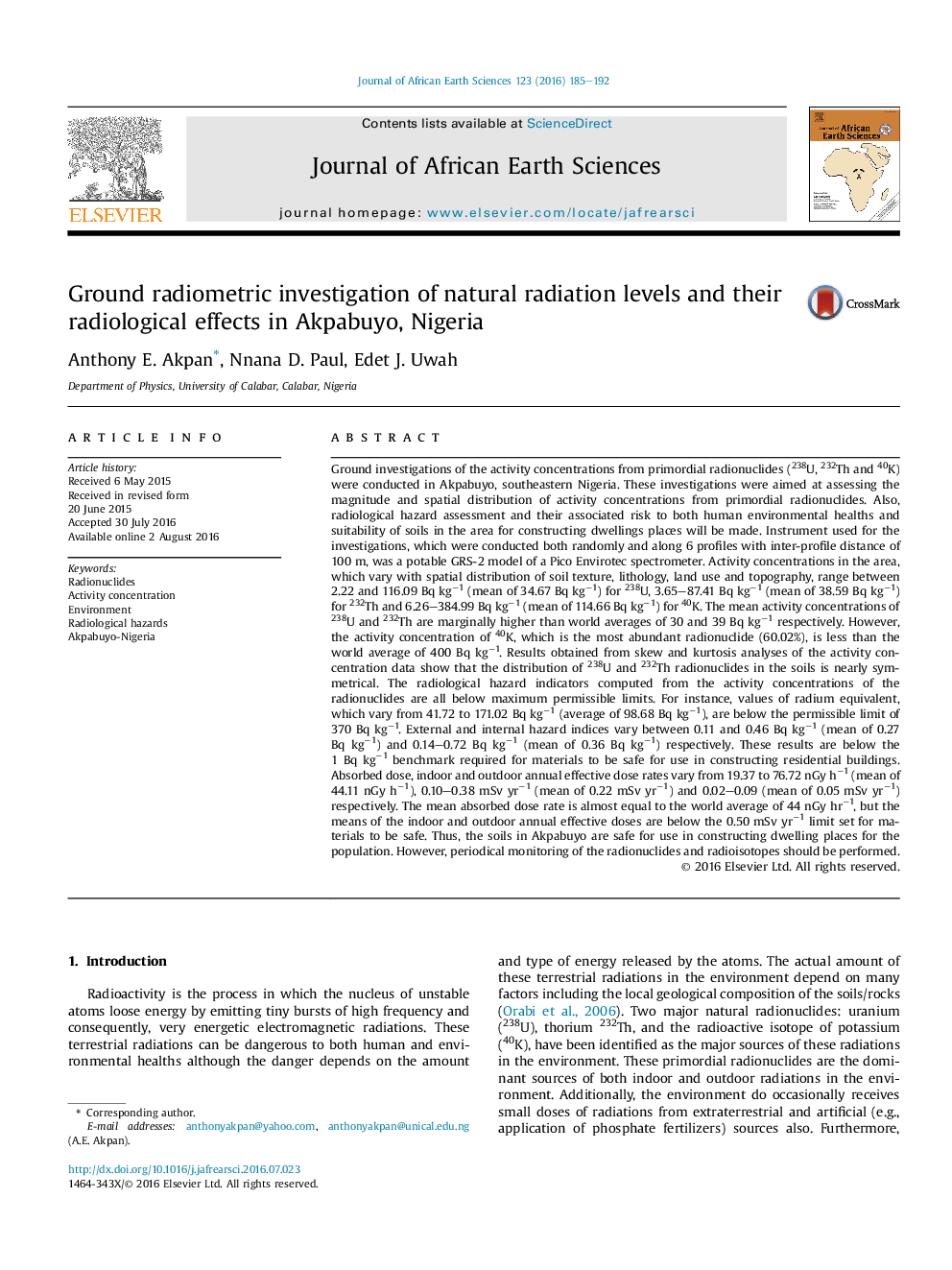| کد مقاله | کد نشریه | سال انتشار | مقاله انگلیسی | نسخه تمام متن |
|---|---|---|---|---|
| 4728177 | 1640185 | 2016 | 8 صفحه PDF | دانلود رایگان |

• Ground radiometric investigations were performed in Akpabuyo-Nigeria.
• Assessment of activity concentrations and radiological effects were made.
• All results are below permissible limits and therefore the area is safe.
Ground investigations of the activity concentrations from primordial radionuclides (238U, 232Th and 40K) were conducted in Akpabuyo, southeastern Nigeria. These investigations were aimed at assessing the magnitude and spatial distribution of activity concentrations from primordial radionuclides. Also, radiological hazard assessment and their associated risk to both human environmental healths and suitability of soils in the area for constructing dwellings places will be made. Instrument used for the investigations, which were conducted both randomly and along 6 profiles with inter-profile distance of 100 m, was a potable GRS-2 model of a Pico Envirotec spectrometer. Activity concentrations in the area, which vary with spatial distribution of soil texture, lithology, land use and topography, range between 2.22 and 116.09 Bq kg−1 (mean of 34.67 Bq kg−1) for 238U, 3.65–87.41 Bq kg−1 (mean of 38.59 Bq kg−1) for 232Th and 6.26–384.99 Bq kg−1 (mean of 114.66 Bq kg−1) for 40K. The mean activity concentrations of 238U and 232Th are marginally higher than world averages of 30 and 39 Bq kg−1 respectively. However, the activity concentration of 40K, which is the most abundant radionuclide (60.02%), is less than the world average of 400 Bq kg−1. Results obtained from skew and kurtosis analyses of the activity concentration data show that the distribution of 238U and 232Th radionuclides in the soils is nearly symmetrical. The radiological hazard indicators computed from the activity concentrations of the radionuclides are all below maximum permissible limits. For instance, values of radium equivalent, which vary from 41.72 to 171.02 Bq kg−1 (average of 98.68 Bq kg−1), are below the permissible limit of 370 Bq kg−1. External and internal hazard indices vary between 0.11 and 0.46 Bq kg−1 (mean of 0.27 Bq kg−1) and 0.14–0.72 Bq kg−1 (mean of 0.36 Bq kg−1) respectively. These results are below the 1 Bq kg−1 benchmark required for materials to be safe for use in constructing residential buildings. Absorbed dose, indoor and outdoor annual effective dose rates vary from 19.37 to 76.72 nGy h−1 (mean of 44.11 nGy h−1), 0.10–0.38 mSv yr−1 (mean of 0.22 mSv yr−1) and 0.02–0.09 (mean of 0.05 mSv yr−1) respectively. The mean absorbed dose rate is almost equal to the world average of 44 nGy hr−1, but the means of the indoor and outdoor annual effective doses are below the 0.50 mSv yr−1 limit set for materials to be safe. Thus, the soils in Akpabuyo are safe for use in constructing dwelling places for the population. However, periodical monitoring of the radionuclides and radioisotopes should be performed.
Journal: Journal of African Earth Sciences - Volume 123, November 2016, Pages 185–192